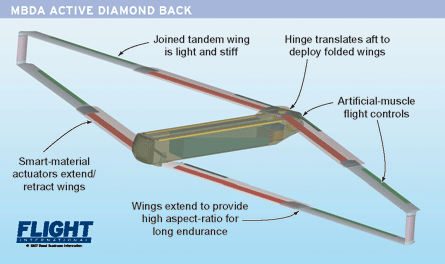Weapons manufacturer MBDA is preparing for windtunnel tests of an airframe design for a persistent loitering munition that draws on experience with its Diamond Back range-extending wing kit for the Joint Direct Attack Munition and Small Diameter Bomb. The Active Diamond Back (ADB) design is a deployable joined tandem wing with variable aspect ratio and "artificial-muscle" flight controls.

The airframe design is aimed at an emerging requirement for munitions that can loiter over the battlefield, says Hank O'Shea, ADB programme manager with MBDA's Westlake Village, California operation. The company is working with the US Air Force Research Laboratory, which has also supported efforts by Boeing to flight-test a persistent munition technology demonstrator under the Area Dominator programme.
Windtunnel tests are scheduled for May-June, and are due to be followed by flight tests late this year or early next. Windtunnel testing will involve a 1/3rd-scale model of a 3.7m (12ft)-span, 45kg (100lb) munition with more than 24h endurance.
For compressed carriage on a fighter's weapons racks, the ADB's upper and lower wings fold to lie along the top and bottom of the munition body. After release, the upper hinge translates aft, deploying the joined tandem wing. The wing panels then extend to double the aspect-ratio for low drag and long endurance. The vertical surfaces joining the wing tips provide a lightweight, flutter-resistant structure.
To avoid complex and heavy mechanical linkages, MDBA plans to use embedded smart-material actuators for both flight control and to extend and retract the wings. The flight controls will use electro-active polymer "artificial muscle" actuators - materials that expand when electrically stimulated, smoothly deforming the wing.
"We will have a self-contained set of flight controls in the wings, with no linkages that have to accommodate the folding and extending," says O'Shea. "It will also free up space in the fuselage for fuel."
The initial design concept used another type of smart-material actuator, a hybrid shape-memory composite and elastomer, to extend the wings non-reversibly. But O'Shea says studies show there may be value in being able to retract the wings once they have been extended and the company is looking at reversible approaches.
Source: Flight International













